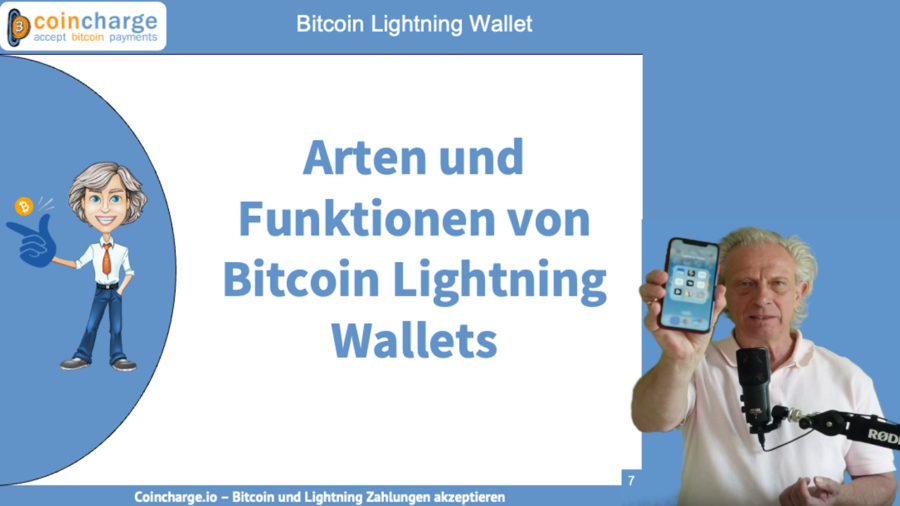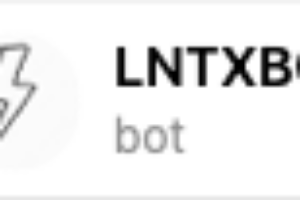In this article we will talk about the different types of Bitcoin lightning wallets, their features and differences, as well as the advantages and disadvantages of Bitcoin lightning wallets where you keep your funds yourself or have them kept.
This article is intended to provide an overview and help understand what a Bitcoin Lightning Wallet is, how it works, and help find the best Bitcoin Lightning Wallet for your needs.
We will talk about the following topics:
- What is a Lightning Wallet?
- Why do you need a Lightning Wallet?
- What types of Lightning Wallets are there?
- What are the functions?
- How safe is my balance in a Lightning Wallet?
Types and functions of Bitcoin Lightning Wallets.
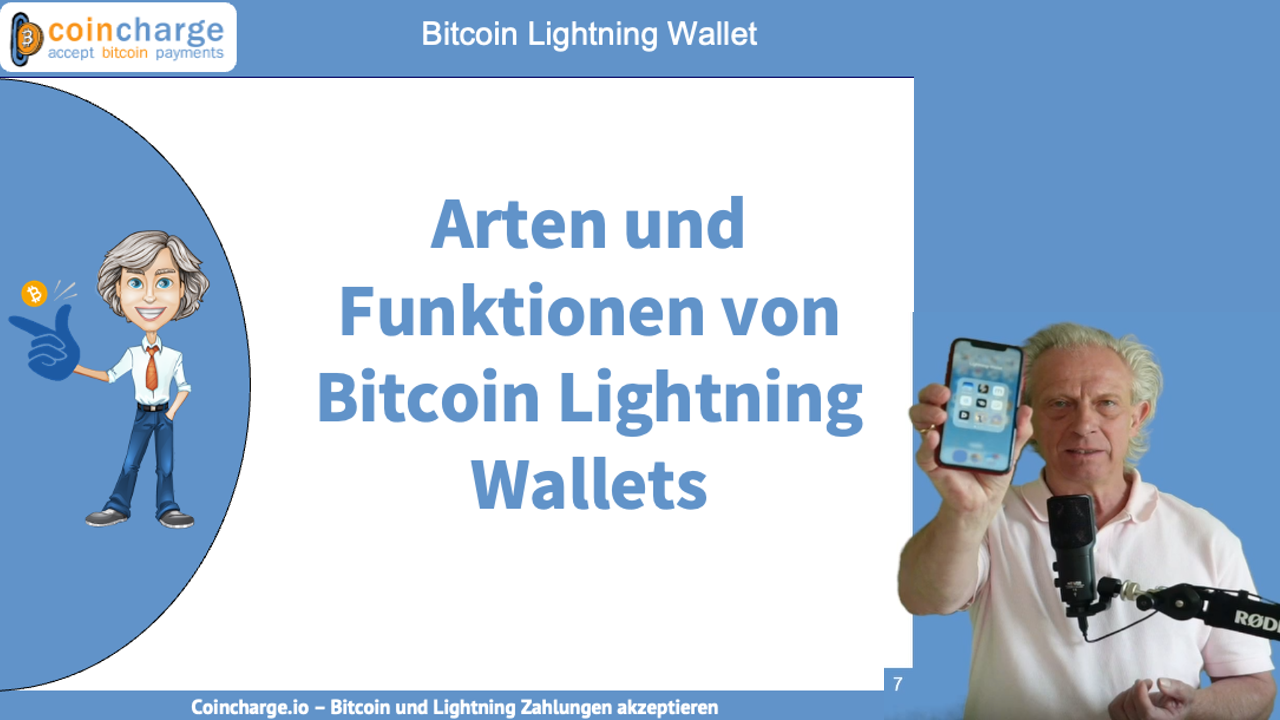
In a further article, we will talk about how to store the funds on the Bitcoin Lightning Wallet.
The difference between the Bitcoin balance being held by a third party and the Bitcoin Lightning Wallet being held and managed by the user himself.
In English we speak of Custodial Lightning Wallet vs. Non-Custodial or Self-Custody Lightning Wallets.
What are the advantages and disadvantages of these two different custody types?
Depending on the custody type, what are the fees for using a Lightning Wallet?
We then give an overview of the different Lightning Wallets for beginners, advanced users and operators of their own Lightning Node.
You can find this second part under: Custodial and Non-Custodial Lightning Wallet or Custody of Bitcoin funds on a Bitcoin Lightning Wallet.
This post is also available as a video on the joint YouTube channel of Coincharge and Coinpages in German language titled: “Arten und Funktionen von Bitcoin Lightning Wallet”.
What is a Bitcoin Lightning Wallet and what is it needed for?
The Lightning network is a payment network based on the Bitcoin blockchain. How this Lightning network works, we have in the video: How does the Lightning network work? What is the Lightning Network? explained.
If you want to be part of this Lightning network yourself, you run your own Lightning Node. On a Lightning Node is the complete Bitcoin Blockchain, a Bitcoin Node and a Lightning Node.
These Lightning Nodes are connected to each other via payment channels and Lightning payments are then processed through them.
What is a Bitcoin Lightning Wallet?
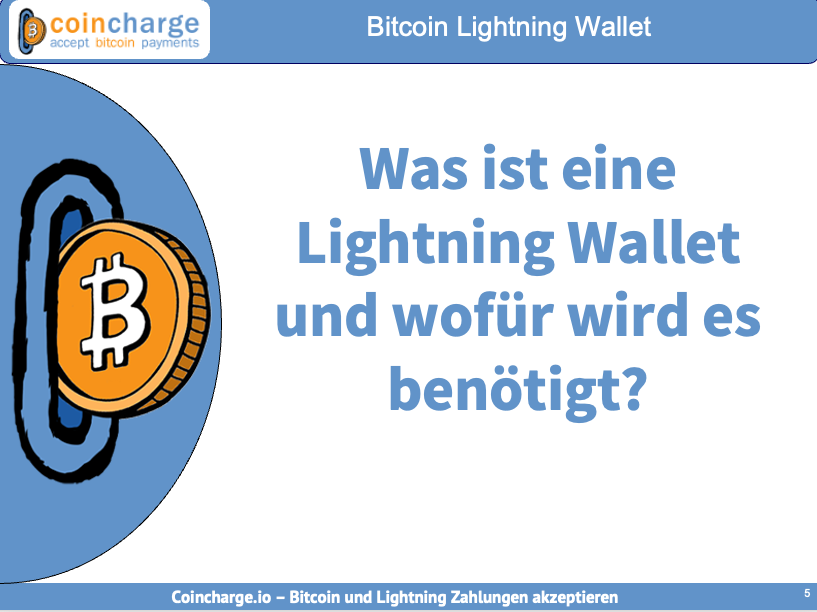
If you want to use the Lightning network yourself to send or receive Lightning payments, it is not necessary to run your own Lightning Node.
As a user, you need your own Lightning Wallet. With this Lightning wallet you can send and receive Bitcoin and Lightning payments.
Now you might say, wait a minute, I already have a Bitcoin wallet where I keep my Bitcoins. Then you probably have a Bitcoin hardware wallet. On it you store your Bitcoin safely, according to the rule “Not you Keys -Not you Bitcoin”.
Such a Bitcoin wallet is perfect for saving Bitcoin safely and for the long term. So to Hodln.
This Bitcoin hardware wallet is kept in a safe place and is almost never needed.
If you now want to pay with it, then such a Bitcoin hardware wallet is completely unsuitable.
If you want to pay or receive payments with Bitcoin, then a Bitcoin Lightning Wallet is more suitable.
A Bitcoin wallet is suitable for saving, i.e. Hodln of Bitcoin and a Lightning wallet is intended for payment, i.e. Spendl.
What types of Lightning Wallets are there?
Lightning wallets can be divided according to the platform on which they are used.
Smartphone Lightning Wallet
The most common usage is on a smartphone.
Where we as payers are shown a QR code, we can scan this QR code with our smartphone and pay.
We always have our smartphone with us and can use it to pay in stores, restaurants at the so-called point of sale.
The smartphone can also be used to pay on the Internet.
Either we get the QR code displayed on the computer and scan it with our smartphone Lightning Wallet, or we click the QR code when we get to a website where we want to pay even with our smartphone.
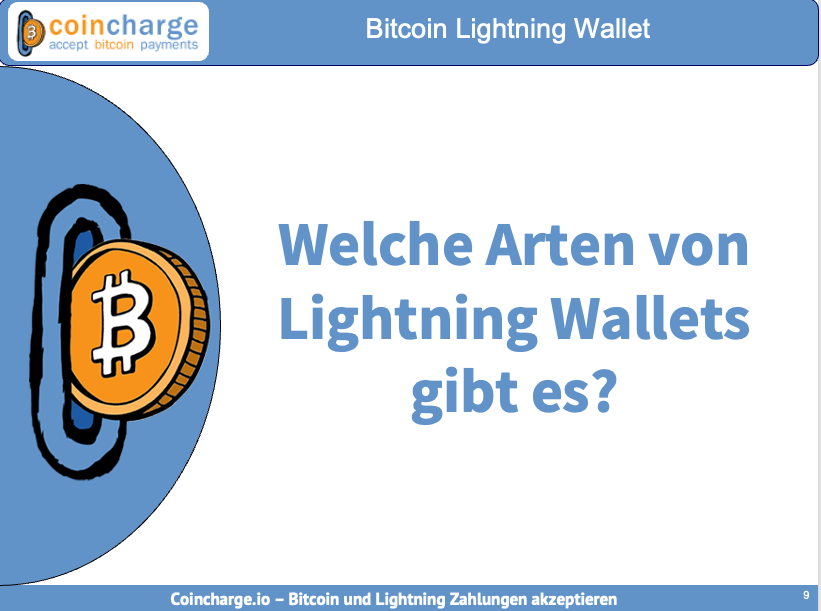
Browser extension
Then there are Lightning Wallets that work as a browser extension. In my internet browser, I install an extension that works as a Lightning Wallet.
When I get to a website where I can pay with Lightning, I don’t need to whip out my smartphone, I can pay with one click.
Here we recommend the Lightning Wallet from Getalby, which we will discuss again at a later point.
Web Wallet
Then there are Lightning Wallets, which are operated through a website. Here, users can sign up on a website and are provided with the features of a Lightning Wallet.
When logged in to this website, you can send and receive Lightning payments.
A Lightning wallet as a web wallet is mainly found on platforms and internet services where you need Lightning credit to use the service.
Here, for example, Bitrefil is worth mentioning. This is a provider of gift cards and stored value cards and cell phone credit.
Here you get a Lightning Wallet and can deposit to your own Lightning Wallet. With this credit you can then shop at Bitrefill.
Other providers of online games, sports betting or trading platforms such as LNmarkets, where you make a deposit to your Lightning Wallet and then use it to conduct the corresponding transactions.
Desktop Wallet
Then there are Lightning Wallets, such as BlueWallet, which you can install on your desktop.
Server Lightning Wallet
Then there are the Lightning Wallets that you run on your server if you have a Lightning Node installed there. These Lightning Wallets are designed for those who run their own Lightning Node.
These are either Lightning Wallets, which are required for the administration of the Lightning Node, such as RTL or Thunderhub.
Or they are Lightning wallets that interact with a corresponding Lightning service, such as on LNbits or LNbanks on the BTCPay server.
What features are supported by Lightning Wallet?
Sending and receiving Lightning payments
The basic function of a Lightning Wallet is to send and receive Lightning payments.
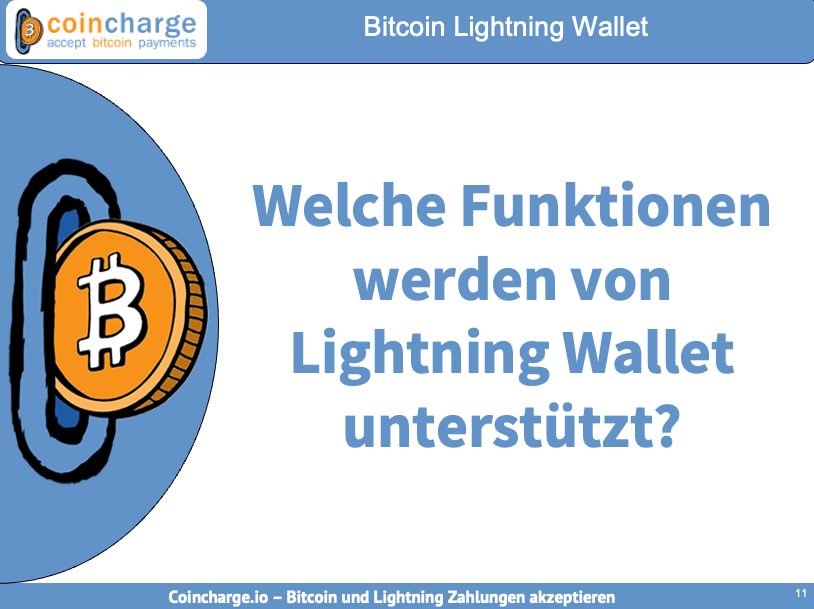
Sending and receiving bitcoin
However, a Lightning Wallet can also receive and send Bitcoin.
For example, to top up a Lightning Wallet, you can deposit Bitcoin.
The incoming Onchain Bitcoin are then exchanged for Lightning and credited to the Lightning Wallet.
This also works if you want to make a payment in Bitcoin.
The Lightning balance is then exchanged from the Lightning wallet back into Onchain and you can use it to pay a Bitcoin invoice.
Lightning Address
A Lightning wallet provides a Lightning address. A Lightning address looks like an email address, except that you can use it to receive Lightning payments, not emails.
With a Lightning Wallet you can also make payments to Lightning addresses.
A Lightning address is ideal for receiving Lightning payments without having to create a Lightning invoice first.
For example, if you want to receive donations or simply make a payment to someone.
If you want, you can send some sats to my Lightning address onleines@getalby.com with your Lightning wallet.
More information in the article about Lightning address
Lightning Login
Lightning Login can be used to perform authorizations, registrations or logins to external services and websites. The advantage for the user is that no personal information has to be disclosed. Registration on these websites is anonymous.
On the Lightning login page you will be shown a QR code, which you scan with a Lightning Wallet and you are registered.
When you want to log in again later, scan the QR code with the same Lightning Wallet and you will be logged back into your account.
More information in the article Lightning Login
Separate Bitcoin Wallet or Fiat Wallet
With most Lightning wallets, the wallet balance is held in Lightning. However, there are also Lightning wallets that additionally have other wallets integrated.
BlueWallet, for example, has a standalone Bitcoin wallet. This makes it possible to manage Lightning and Bitcoin balances in separate wallets.
The Lightning Wallet Blink, formerly Bitcoin Beach Wallet, has a US Dollar Wallet in addition to the Lightning Wallet. The user can decide whether to hold or split his wallet balance in Bitcoin Lightning or USD.
Point of Sale Lightning Wallet
Then there are Lightning wallets specifically for stores to accept Bitcoin or Lightning payments. Anyone who wants to accept Lightning payments in their business, restaurant or retail store can install Lipa’s Lightning Wallet on their smartphone and accept Lightning payments.
Breez’s Lightning Wallet also has a built-in PoS feature that allows merchants to accept Lightning payments.
Podcasting Lightning Wallet
Then there’s Fountain’s Lightning Wallet, which doubles as a podcast app. With this Lightning Wallet you can listen to podcasts and support the podcast financially with Lightning Payments.
Social Media Lightning Wallet
Social media lightning wallets are specialized or optimized for sending and receiving lightning payments within a social media platform.
On Telegram, for example, there is the LightningTipBot or on Nostr the Lightning Wallet from Current.
What are the components of a Bitcoin Lightning Wallet?
Lightning Node
As users and operators of a Lightning wallet, we do not see which components in the background ensure that we can send and receive Lightning payments.
Because in the background, we need a complete Lightning Node for our Lightning Wallet. However, we do not have to operate this ourselves; the provider of the Lightning Wallet does this for us.
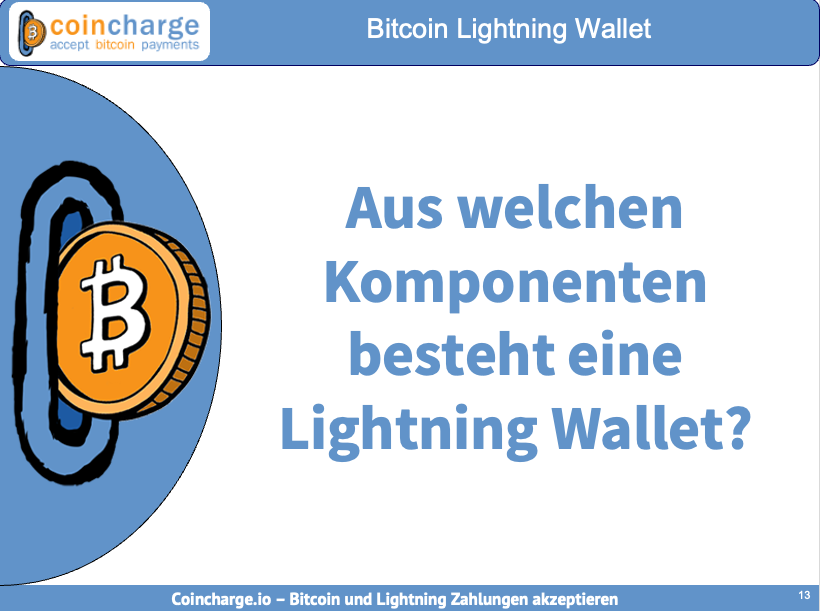
Bitcoin Node with Bitcoin Blockchain
A Lightning Node is based on a Bitcoin Node with the Bitcoin Blockchain and therefore requires a Bitcoin Node.
Knowledge about all nodes and payment channels
Then a database is needed that knows all nodes and channels of the Lightning network, so that it is known where and through which nodes a payment can be made.
Channel Manager
Then some kind of channel manager is needed to organize the opening and closing of channels.
Determine payment path
And a system for determining the optimal payment method.
As described earlier, these components do not need to be integrated directly into the Lightning Wallet, but the Lightning Wallet must be able to use these components, which may be managed in another external location.
If you imagine the size of the Bitcoin blockchain alone, you can imagine that it cannot be stored on a smartphone.
Keystore
The most important part is the associated keystore. This is where the private keys are kept to perform the necessary signing of Lightning payments.
If the keys are on their own Lightning wallet, the wallet owner also has full access to their Lightning credit.
If the private key is held by the provider of the Lightning Wallet, the credit does not belong to you, but to the provider.
How safe is my balance on a Bitcoin Lightning Wallet?
As mentioned earlier, it depends on who has access to the private keys, as only they have access to the funds in the Lightning Wallet.
If the keys are held by the provider of the lightning wallet, this is referred to as a custodial wallet.
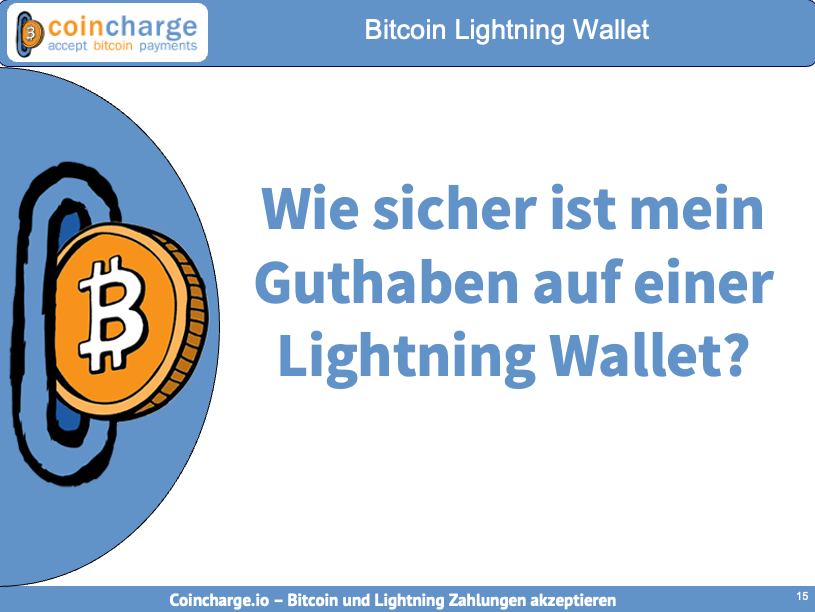
If one holds the private keys oneself, one speaks of non-custodial or better self-custody, which can be translated as self-custody.
The European Union has enacted crypto regulation with MiCa and introduced the terms hosted and unhosted wallet.
A hosted wallet is a custodial wallet, i.e. a wallet where the funds are held by a service provider or bank. An unhosted wallet is when you manage your crypto assets yourself.

We will discuss the differences between third-party and self-managed Bitcoin Lightning wallets in more detail in the second part.
Likewise, we will talk about what are the advantages and disadvantages of third-party managed to self-managed Lightning Wallet.
What fees are incurred when using third-party or self-managed Lightning Wallets and then we give an overview of the different Lightning Wallets for beginners, advanced users and operators of their own Lightning Node.

